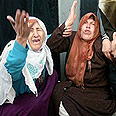
Beit Hanoun following IDF shelling
צילום: רויטרס
The mystery shells
Gaza bombardment that left 18 Palestinians dead raises some questions
Those who couldn't sleep last night, fearing that Israel's reputation would be tainted, can rest assured: Our reputation has long been tainted. Israel is perceived worldwide as a nation that is quick to pull the trigger against civilians. Whether it's true or not, this is the situation, and no commission of inquiry will be able to delve into the complexity of technical data to prove undisputedly that we were in order, that we tried, that we did everything we could, but alas, we screwed up.
For our own sakes we must understand what really happened early Wednesday morning in Beit Hanoun. We absolutely must, because our hearts have hardened. Ten dead here, 60 dead there, and on Wednesday another 18, including many innocent civilians. Here in Israel we take such occurrences in our stride, yet we must ask ourselves: Is it really necessary? Does it really serve our national interests? We deserve to know whether such occurrences simply boil down to bad luck, or whether this bad luck is built into the system. When messing around with artillery near crowded urban areas – even when taking into account all the safety margins, orders and protocol – a disaster can be expected. Unexpected and unplanned scenarios can always be expected. It's an integral part of the game.
Wednesday's mishap in Beit Hanoun is very strange. It is doubtful whether a commission of inquiry would be able to decipher the event in a single day. According to IDF information, Hamas operatives from the Jabaliya refugee camp were supposed to arrive in Beit Hanoun, set up rocket launchers and fire Qassam rockets towards Ashkelon. It was estimated that the rocket fire would commence during the early morning hours in order to target Israeli children on their way to school.
An IDF order was given to carry our preventative artillery fire while employing every possible safety measure: Only one cannon would fire at a time to minimize error; the fire was directed slowly: 12 shells within 16 minutes. The team monitoring the landing of the shells could halt the fire at any given moment and amend deviations if necessary.
On Wednesday the IDF team fired at two targets from outside Beit Hanoun. Two cannons were used, each aimed at a different target. One cannon fired 12 shells and completed its mission successfully. A second cannon fired 12 shells, killing 18 people and injuring dozens. The Palestinians reported that two shells hit a house. Aerial photography taken following the shelling showed two or three billows of smoke at a radius of 60-70 meters.
Something doesn't add up
The radar that locates the targets transferred data showing that 10 shells from one barrage landed at a distance of 400 meters from the house that was hit. The two remaining shells were not detected by the radar. This is a familiar statistical phenomenon. Nonetheless, it doesn't make sense that only some of the shells fired from the same cannon would go off course to such an extent, even if they didn't show up on the radar. If only two shells landed inside a residential neighborhood, where did the others land?
One of the possibilities investigated Wednesday is a technical failure of the radar itself. Artillery experts contend that the extent of damage and death reported by Beit Hanoun residents proves that at least eight shells landed there.
Such an error with this type of radar is very rare. So perhaps something else occurred? Perhaps a shell hit an arms cache or Qassam rockets that exploded? Something doesn't add up. The performance of the artillery team was investigated, and so was the use of digital target data that came from the battery's control center, but no shortcomings were found. The investigation examined whether the military division transferred the wrong data regarding the location of the target. This is highly doubtful as well.
One question has not been asked: Why was the landing of the shells not monitored by human eyes? No one tracked or saw with his or her eyes the actual landing of the shells. This is, after all, the most logical thing to do when firing at urban areas.
As of now the mystery remains; a one-day-old commission of inquiry is not enough to provide real answers.










